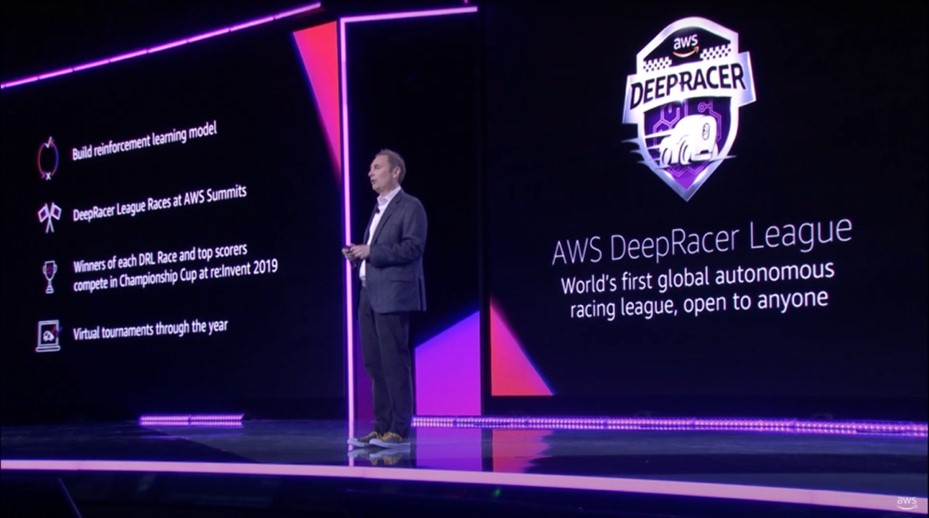In 2018, I sat in the audience at AWS re:Invent as Andy Jassy announced AWS DeepRacer—a fully autonomous 1/18th scale race car driven by reinforcement learning. At the time, I knew little about AI or machine learning (ML). As an engineer transitioning from legacy networks to cloud technologies, I had never considered myself a developer. But AWS DeepRacer instantly captured my interest with its promise that even inexperienced developers could get involved in AI and ML.

The AWS DeepRacer League was also announced, featuring physical races at AWS Summits worldwide in 2019 and a virtual league in a simulated environment. Winners would qualify to compete for the grand champion title in Las Vegas the following year. For 2018, because AWS DeepRacer had just been unveiled, re:Invent attendees could compete in person at the MGM Grand using pre-trained models.
My colleagues and I from JigsawXYZ immediately headed to the MGM Grand after the keynote. Despite long queues, we persevered, observing others racing while we waited. Participants answered questions about driving preferences to select a pre-trained model. Unlike later competitions, racers had to physically follow the car and place it back on track when it veered off.
We noticed that the AWS-provided models were unstable and slow by today’s standards, frequently going off-track. We concluded that quickly replacing the car on the track could result in a good lap time. Using this strategy, we secured second place on the leaderboard.
The night before the finals, we learned that we had qualified because of a dropout. Panic set in as we realized we would be competing on stage in front of thousands of people while knowing little about ML. We frantically tried to train a model overnight to avoid embarrassment.
The next morning, we found ourselves in the front row of the main auditorium, next to Andy Jassy. Our boss, Rick Fish, represented our team. After an energetic introduction from Indycar commentator Ryan Myrehn, Rick set a lap time of 51.50 seconds, securing the 2018 AWS DeepRacer grand champion title!

Image 2 – Rick Fish accepting the AWS DeepRacer trophy from Matt Wood
2019: Building a community and diving deeper
Back in London, interest in AWS DeepRacer exploded. We spoke at multiple events, including hosting our own An evening with DeepRacer gathering. As the 2019 season approached, I needed to earn my own finals spot. I began training models in the AWS DeepRacer console and experimenting with the physical car, including remote control and first-person view projects.
At the 2019 London AWS Summit, I won the AWS DeepRacer Championship with a lap time of 8.9 seconds, a significant improvement from the previous year. This event also sparked the creation of the AWS DeepRacer Community, which has since grown to over 45,000 members.
My interest in understanding the inner workings of AWS DeepRacer grew. I contributed to open source projects that allowed running the training stack locally, diving deep into AWS services such as Amazon SageMaker and AWS RoboMaker. These efforts led to my nomination as an AWS Community Builder.
Working on community projects improved my skills in Python, Jupyter, numpy, pandas, and ROS. These experiences proved invaluable when I joined Unitary, an AI startup focused on reducing harmful online content. Within a year, we built a world-class inference platform processing over 2 billion video frames daily using dynamically scaled Amazon Elastic Kubernetes Service (Amazon EKS) clusters.

Image 3 – Unitary at the AWS London Summit showcasing dynamically scaled inference using 1000+ EKS nodes
2020-2023: Virtual racing and continued growth
The COVID-19 pandemic shifted AWS DeepRacer competitions online for 2020 and 2021. Despite this, exciting events like the AWS DeepRacer F1 Pro-Am kept the community engaged. The introduction of the AWS DeepRacer Evo, with stereo cameras and a lidar detector, marked a significant hardware upgrade.
In-person racing returned in 2022, and I set a new world record at the London Summit. While I didn’t win the finals that year, the experience of competing and connecting with fellow racers remained invaluable.

Images 4 & 5 – the author hoists the trophy from the 2022 London Summit (left) DeepRacer Community members and Pit Crew hosting a AWS DeepRacer workshop at re:Invent 2023 (right)
2023 brought more intense competition. Although I set another world record in London, it wasn’t enough for first place. I eventually secured a finals spot by winning a virtual league round for Europe. While my performance in the finals didn’t improve on previous results, the opportunity to reconnect with the AWS DeepRacer community was rewarding.
Conclusion: The lasting impact of AWS DeepRacer
Over the past six years, AWS DeepRacer has profoundly impacted my professional and personal life. It has helped me develop a strong foundation in AI and ML, improve my coding skills, and build a network of friends and professional contacts in the tech industry. The experience gained through AWS DeepRacer directly contributed to my success at Unitary, where we’ve achieved recognition as a top UK startup.
As the official AWS DeepRacer league comes to an end, I’m excited to see what the community will achieve next. This journey has shaped my career and life in ways I never expected when I first saw that small autonomous car on stage in 2018.
For those interested in starting their own AI and ML journey, I encourage you to explore the AWS DeepRacer resources available on the AWS website. You can also join the thriving community on Discord to connect with other enthusiasts and learn from their experiences.
About the author
Matt Camp is an AI and ML enthusiast who has been involved with AWS DeepRacer since its inception. He is currently working at Unitary, applying his skills to develop cutting-edge content moderation technology. Matt is an AWS Community Builder and continues to contribute to open source projects in the AWS DeepRacer community.
Source: Read MoreÂ

